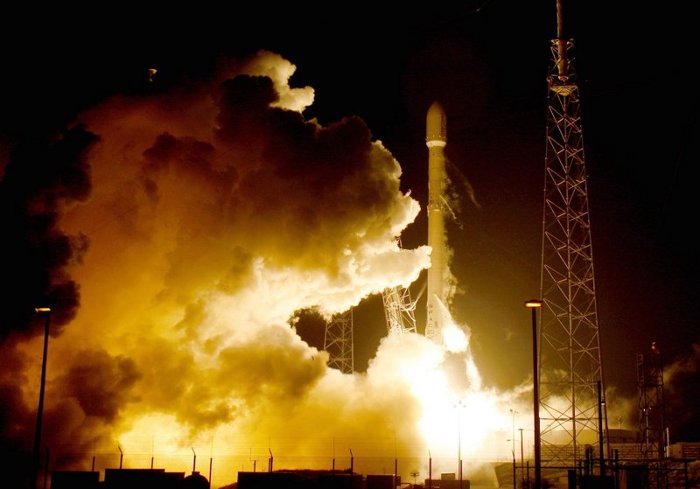How does the missile reuse affect the aviation industry and the universe?
On Monday, December 21, SpaceX Corporation fired a rocket into space and landed it back to the ground, in a state of complete intact. Not only creating a historic turning point in the manufacture of missiles for reuse, the above success has a great impact on the future of space tourism. As Elon Musk has revealed, the total cost of launching Falcon 9 missiles into space is up to $ 61.2 million. But now, through the reuse of rockets, this number could be reduced to just 612,000 US dollars, even lower.
A terrible business model
For nearly 60 years, the space industry has survived, although the traditional business model will quickly submerge any company. The reason is because the aerospace industry operates primarily through missiles, while it takes tens to hundreds of millions of dollars to build and launch into space, only once. Obviously literally, this money all went into smoke after every launch. After a missile completes its mission, most will fall back to earth, in the ocean, then sink to the bottom and never be seen again.

The entire cost of the Falcon 9 missile launch mission into space is up to $ 61.2 million.(Photo: Businessinsider).
Try to think the same thing for the aviation industry, after every flight people throw away the aircraft, it is true that "money has a mountain is not enough" . According to Waitbutwhy author Tim Urban, if the airlines also do the above assumptions, we will have to pay $ 1.5 million for each seat on the plane.
"It costs about $ 300 million to complete an airplane. So in this new model, in addition to paying crew and fuel, the airline has to spend an additional $ 300 million after each flight to To give away another plane, the amount paid for a round-trip ticket between Chicago and San Francisco will now be about 1.5 million USD. "
Rockets are reliable and sustainable

SpaceX is owned by businessman Elon Musk.(Photo: Businessinsider).
It can be said that the Space Exploration Technology Corporation (SpaceX) made it on Monday last week to set a new phase for the era of re-launch missiles - missiles that can carry goods on funds. directed more than once. However, SpaceX always knew he was a private company. Therefore, the company cannot operate on an endless budget like US government space agencies, which dominate the aerospace industry in the country during the second half of the 20th century.
SpaceX is owned by businessman Elon Musk, needing to find a way to become a reliable, sustainable development brand, and a reusable missile is the key to the problem. Musk has known this since SpaceX launched his first rocket into orbit in 2008. Since then, they have been working nonstop to look forward to what was achieved last Monday and that is only the beginning.
Now, SpaceX will have to prove that they can always do what they have done. Meanwhile, one of SpaceX's biggest competitors, the French-based company Arianespace, is currently discussing the potential of reuse technology, but it is still in its infancy. preliminary design.
Open the road to Mars

SpaceX's Dragon spacecraft.(Photo: NBCNews).
Last November, Jeff Bezos' Blue Origin company put New Shepard missiles into space, reached an altitude of nearly 100km above the ground, then landed on Earth, similar to what SpaceX had done. with Falcon 9. However, unlike SpaceX, the Blue Origin missile is inaccessible to space trajectories, which is an important ability in bringing "goods" into space as well as moving to distant destinations. sticky like Mars.
Furthermore, New Shepard must take more power to get into orbit, and SpaceX's Falcon 9 is 15 times stronger than the Blue Origin missile. Ben Thompson - founder of Stratechery site said: "What SpaceX does is only similar to Blue Origin, as well as the difference between an airplane and a handball, or if you are more generous, you can assume that that's the difference between an airplane and a balloon. "
In addition to reducing the cost of space transport, SpaceX's reusable missile could also be an important factor in sending humans to Mars. NASA announced plans to do this in the 2030s, but they insisted that it would be a round trip. In order for that to happen, you must have a rocket up to Mars, which can then take astronauts away and return to Earth after they complete the mission. This requires a rockets capable of safely responding to the ground, like what we saw Monday night.
- These ideas may create a real revolution in the aviation industry
- 25 secret aviation has never been revealed
- US reuse missiles reach new heights
- 'Revolution' aviation: egg-shaped aircraft engine
- NASA released an image that recorded the Antares missile explosion last year
- SpaceX will continue to land missiles at sea on January 17
- 'Secrets' have never been revealed about aviation
- AG600: Largest marine seaplane in the world
- UK: Reduce air pollution
- NASA destroyed the missile after the failed launch
- 7 most explosive
- 8 ways to reuse plastic bags are good, you should apply as soon as possible
 Van Allen's belt and evidence that the Apollo 11 mission to the Moon was myth
Van Allen's belt and evidence that the Apollo 11 mission to the Moon was myth The levels of civilization in the universe (Kardashev scale)
The levels of civilization in the universe (Kardashev scale) Today Mars, the sun and the Earth are aligned
Today Mars, the sun and the Earth are aligned The Amazon owner announced a secret plan to build a space base for thousands of people
The Amazon owner announced a secret plan to build a space base for thousands of people